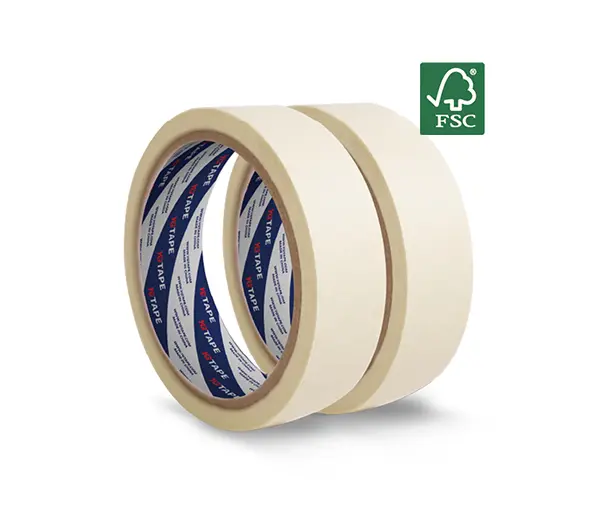Masking Tape vs Painter's Tape: Don't Ruin Your Paint Job!




If you've ever tackled a DIY project or professional painting job, you've likely reached for a roll of tape. But have you ever picked one up and wondered, "Is this regular masking tape, or is it the painter's tape I'm supposed to use?"
This is a common question, and the answer can make the difference between a professional-looking finish and a disappointing one. Using the wrong tape can lead to messy bleed-through, jagged edges, and even surface damage upon removal.
This ultimate guide will break down the differences between Masking Tape and Painter's Tape in detail, empowering you to make the perfect choice for your next project.
The Quick Answer: Are They the Same Thing?
The short answer: All painter's tape is masking tape, but not all masking tape is designed for painting.
Think of it like this: all squares are rectangles, but not all rectangles are squares. "Masking Tape" is a broader category for general-purpose covering and protection. "Painter's Tape" is a specific, high-performance type of masking tape engineered with unique features for painting projects.
Detailed Comparison: Masking Tape vs. Painter's Tape
Let's clear up the confusion with a direct, side-by-side comparison:
| Feature | Masking Tape | Painter's Tape |
|---|---|---|
| Primary Use | General masking, holding, bundling, labeling | Specifically designed for painting; creating sharp, clean lines. |
| Adhesive Strength | Medium to high; stronger bond. | Low-tack; easy removal and residue-free. |
| Composition | Often a rough crepe paper with a strong rubber adhesive. | A higher-grade crepe paper with a surface-safe acrylic adhesive. |
| Paint Bleed Resistance | Poor; paint (especially solvents) can seep underneath. | Excellent; features a built-in seal to prevent paint bleed. |
| Removal & Residue | Can leave sticky residue; may tear if left on too long. | Clean removal; leaves no residue on most surfaces (when used correctly). |
| Surface Compatibility | Works on many surfaces but can damage delicate ones like fresh paint. | Made for delicate surfaces (drywall, trim, fresh paint). |
| Cost | Generally less expensive. | Generally more expensive, but pays for a professional result. |
When to Use Which Tape? (Your Decision Guide)
Now that you know the differences, here’s how to choose for your project:
When to Use Standard Masking Tape:
-
General Holding & Bundling: Temporarily holding down carpets, sealing moving boxes.
-
Industrial or Heavy-Duty Masking: Protecting areas that don't need to stay pristine, like masking off pipes during construction.
-
Non-Painting Crafts: Some crafts or temporary fixes that require a stronger hold.
-
Low-Budget, Short-Term Tasks: Simple, short jobs where a perfect finish isn't necessary.
Keywords: general purpose masking tape, heavy duty masking tape, low cost masking tape
When to Use Painter's Tape:
-
Any Painting Project: This is its primary job. Whether painting a room, furniture, or an automotive part.
-
Creating Sharp, Crisp Lines: For painting straight stripes, geometric designs, or a perfect boundary between two colors.
-
On Delicate or Freshly Painted Surfaces: You need the low-tack adhesive to protect the underlying finish.
-
Long-Term Projects: Many painter's tapes can be applied for days without leaving a sticky residue.
-
When Using Latex or Solvent-Based Paints: Its bleed-resistant edge ensures paint doesn't creep underneath.
Keywords: painter's tape for sharp lines, blue painter's tape, delicate surface painter's tape, best tape for painting trim
Pro Tips: How to Use Painter's Tape Correctly
Choosing the right tape is only half the battle. Using it correctly is key to a perfect finish:
-
Clean the Surface: Ensure the surface is dry, clean, and free of dust and grease.
-
Press Firmly: After application, burnish the edge firmly with a fingernail, putty knife, or plastic card. This activates the tape's seal.
-
Remove at the Right Time: Remove the tape while the paint is dry to the touch but not fully cured (typically 60-90 minutes after painting). This gives the cleanest line. If the paint is fully dry, score the edge lightly with a utility knife before peeling to prevent peeling the paint off.
-
Pull at a 45-Degree Angle: Slowly pull the tape back on itself at a 45-degree angle for the smoothest result.
Conclusion: Don't Save on the Wrong Supply
While standard Masking Tape has its place in the toolbox for general chores, investing in high-quality Painter's Tape is non-negotiable for any painting or finishing work.
The slight extra cost is insignificant compared to the time, effort, and frustration it saves you—not to mention the professional, flawless results it delivers.
This is why the fundamentals of tape quality matter. For professionals and DIYers who cannot compromise on performance, sourcing tape from a reputable manufacturer is key. YGtape has been a leading force in the adhesive tape industry since 1999.
As a professional adhesive tape manufacturer with over two decades of experience, Yongguan (YGtape) operates a modern, large-scale production facility.
Our factory is equipped with advanced production lines and a dedicated R&D team, allowing us to control every aspect of quality, from raw material selection to the final product. This vertical integration ensures consistency and reliability that smaller suppliers simply cannot match.
This manufacturing expertise is directly applied to our range of high-performance masking and painter's tapes. We understand that a great painter's tape needs the perfect balance of low-tack adhesion and superior bleed resistance.
YGtape's painter's tapes are engineered to deliver crisp, sharp lines without residue, making them a trusted choice for painters, contractors, and manufacturers worldwide. We offer a wide variety of tapes for different applications, from general purpose to high-temperature and heavy-duty industrial use.
Ready to experience the difference that professional-grade tape makes? 【Explore the YGtape product collection to find the perfect masking and painter's tape for your next project.】
Frequently Asked Questions (FAQ)
Q1: Can I use painter's tape as regular masking tape?
A: Yes, in most cases you can. However, its lower adhesive strength may not be suitable for heavy-duty holding tasks.
Q2: Why did my painter's tape still bleed?
A: The most common cause is not pressing the edge down firmly enough to create a seal. Using a low-quality tape or applying paint too thickly can also cause bleed-through.
Q3: How long can painter's tape be left on?
A: Most high-quality painter's tapes are designed for clean removal for up to 14 days. Always check the manufacturer's specifications and avoid extreme weather conditions.
Q4: What do the different colors of painter's tape mean?
A: Color often indicates the tape's adhesion level and use case. Blue is general-purpose, green is for longer-lasting or slightly rougher surfaces, and purple or pink is often for the most delicate surfaces with the lowest tack.
Q5: Where can I find a reliable supplier for bulk orders of masking tape?
A: For bulk or commercial needs, working directly with a manufacturer like 【YGtape】 is often the best solution. As a factory with strong OEM and export capabilities, we can provide competitive pricing, custom solutions, and consistent quality for large-volume projects, serving clients globally across various industries.











.webp)




